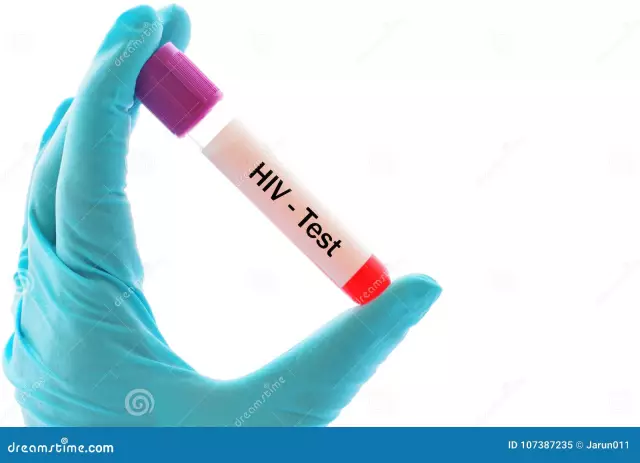- Author Rachel Wainwright [email protected].
- Public 2023-12-15 07:39.
- Last modified 2025-11-02 20:14.
Rheumatoid factor in a blood test
The content of the article:
- Methods for determining rheumatoid factor in a blood test
- A blood test for rheumatoid factor - what is it?
- Rheumatoid factor rate
- High RF in the blood test - what can this mean?
A blood test for the content of rheumatoid factor is a laboratory test that is used in the diagnosis of many autoimmune and infectious diseases.

The rheumatoid factor increases in systemic diseases that occur with the destruction of connective tissue
Rheumatoid factor (RF) is a group of antibodies that react as an antigen with immunoglobulins G, which are produced by the immune system. Rheumatoid factor is formed as a result of excessively high immunological activity of plasma cells in the articular tissue. From the joints, antibodies enter the bloodstream, where they form immune complexes with IgG, which damage the synovial membrane of the joints and the walls of blood vessels, eventually leading to severe systemic damage to the joints. Why is this happening? It is believed that in some diseases, immune cells mistake the body's own tissues for foreign, that is, for antigens, and begin to secrete antibodies to destroy them, but the exact mechanism of the autoimmune process is still not well understood.
Nevertheless, the determination of rheumatoid factor in a blood test makes it possible to diagnose many diseases in the early stages. A referral to the study of rheumatoid factor in the blood is usually given by a traumatologist, rheumatologist or immunologist, since the most common disease diagnosed with this test is rheumatoid arthritis.
Methods for determining rheumatoid factor in a blood test
There are several laboratory techniques for determining rheumatoid factor in a blood test. Most often, quantitative methods for determining RF are used, but for screening a qualitative study can be carried out - a latex test.
Latex test is a type of agglutination reaction (adhesion and precipitation of particles with antigens and antibodies adsorbed on them), which is based on the ability of rheumatoid factor immunoglobulins to react with class G immunoglobulins. For the test, a reagent is used that contains immunoglobulin G adsorbed on particles latex. The presence of agglutination indicates the presence of rheumatoid factor in the blood serum (qualitative test). Despite the fact that this method of analysis is faster and cheaper than others, it is used relatively rarely, since it does not provide information on the amount of rheumatoid factor in the blood.
Another technique that uses the agglutination reaction is the Waaler-Rose test, in which the rheumatoid factor in the blood serum reacts with the red blood cells of a sheep. This method is rarely used today.
More accurate and informative are nephelometry and turbidimetry - methods that allow to determine not only the presence of rheumatoid factor in the blood serum, but also its concentration in different dilutions (quantitative test). The essence of the methods is to measure the intensity of the light flux that passes through the blood plasma with suspended particles. High turbidity means high content of rheumatoid factor. The norms depend on the characteristics of the test in a particular laboratory.
The most commonly used ELISA (enzyme-linked immunosorbent assay). It shows not only the level of rheumatoid factor, but also the ratio of the types of immunoglobulins that are included in it. This method is considered the most accurate and informative.
A blood test for rheumatoid factor - what is it?
To test blood for rheumatoid factor, blood is taken from a vein. Before donating blood, it is necessary to exclude alcohol intake, smoking and physical activity 12 hours before the analysis. During this period, you should not drink tea, coffee and sugary drinks, but clean water will only be useful. It is advisable to stop taking any medications for a while. If this is not possible, the doctor should be told which medications have been taken recently. The analysis is taken on an empty stomach; it is advisable to rest for 10-15 minutes before taking blood.

For analysis for rheumatoid factor, venous blood is taken
As a rule, RF is investigated in combination with two other indicators - CRP (C-reactive protein) and ASL-O (antistreptolysin-O). The determination of these indicators is called rheumatoid tests, or rheumatic tests.
In addition to rheumatoid tests, the following additional studies may be prescribed for the diagnosis of systemic diseases and other immunological pathologies:
- a general blood test with an expanded leukocyte formula - allows you to identify the inflammatory process in the body and tumors of the hematopoietic system;
- ESR (erythrocyte sedimentation rate) - its increase is also a marker of inflammation;
- biochemical blood test - in particular, the level of uric acid, the amount of total protein and the ratio of its fractions are important;
- analysis for anti-CCP (antibodies against cyclic citruline peptide) - allows you to confirm the diagnosis of rheumatoid arthritis;
- determination of antibodies to cell organelles.
Rheumatoid factor rate
Normally, rheumatoid factor in the blood is absent or is determined in a very low concentration. The upper limit of the norm is the same for men and women, but varies with age:
- children (less than 12 years old) - up to 12, 5 IU / ml;
- 12-50 years - up to 14 IU / ml;
- 50 years and older - up to 17 IU / ml.
However, to decipher the results of the analysis, it is necessary to take into account not only the age, but also the individual characteristics of the organism, as well as the research method, therefore, only a doctor can interpret the results and make a diagnosis.
High RF in the blood test - what can this mean?
If the study showed that the rheumatoid factor in the blood test is increased, then there is reason to assume systemic (autoimmune) pathologies, i.e., associated with damage to connective tissue and a chronic inflammatory process. These include:
- Rheumatoid arthritis (RA) is a connective tissue disorder that mainly affects the small joints. The form of RA in which rheumatoid factor rises in the blood serum is called seropositive;
- systemic lupus erythematosus - a disease in which the vessels are affected, which leads to characteristic rashes;
- ankylosing spondylitis (ankylosing spondylitis) is an autoimmune joint disease in which the spine is most affected. The disease with a prolonged course leads to deformity of the spine and stoop;
- systemic scleroderma - characterized by damage to the skin, blood vessels, internal organs and the musculoskeletal system;
- sarcoidosis is a disease in which granulomas form in different organs (most often in the lungs) - foci of the inflammatory process, which look like dense nodules and consist of phagocytic cells;
- dermatomyositis (Wagner's disease) - a pathology in which the skin, blood vessels, skeletal and smooth muscles are affected;
- Sjogren's syndrome is a connective tissue disease in which the salivary and lacrimal glands are the main lesions, which leads to dry eyes and mouth. Sjogren's syndrome can occur primarily or as a complication of other diseases, such as rheumatoid arthritis.
In addition, an increase in rheumatoid factor can be a sign of the following diseases:
- vasculitis is a generalized vascular lesion that can develop in many pathologies (Takayasu's disease, Horton's disease, and others);
- septic endocarditis is a bacterial infection of the inner lining of the heart that covers its cavities and valves. May lead to heart failure and the development of heart defects;
- infectious mononucleosis - a disease that is caused by the herpes-like Epstein-Barr virus. It is acute and is accompanied by fever, damage to internal organs and the appearance of atypical mononuclear cells in the blood;
- tuberculosis, leprosy (Hansen's disease) - infectious diseases that are caused by mycobacteria;
- active viral hepatitis;
- malaria, leishmaniasis, trypanosomiasis and other parasitic diseases;
- oncological diseases - chronic lymphocytic leukemia, Waldenstrom's macroglobulinemia and malignant neoplasms that metastasize in the synovial membrane of the joints.

Rheumatoid arthritis is a deforming lesion of small joints characterized by increased rheumatoid factor
Occasionally (in 2-3% of adults and 5-6% of elderly people), an increase in the rheumatoid factor in the blood is found in healthy people, but in most cases it is a sign of serious pathology, therefore it is a reason for urgent medical attention.
YouTube video related to the article:

Anna Kozlova Medical journalist About the author
Education: Rostov State Medical University, specialty "General Medicine".
Found a mistake in the text? Select it and press Ctrl + Enter.






